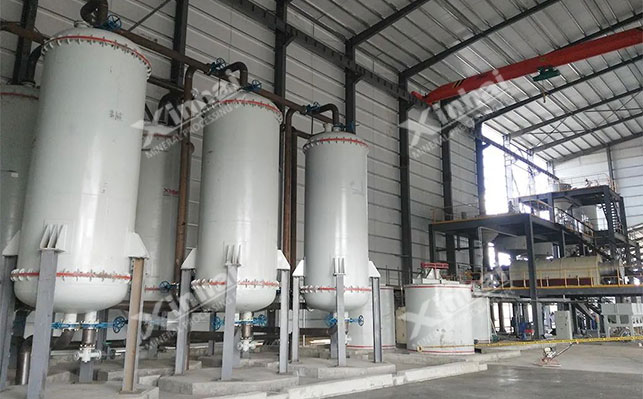
15311826613
Click to add WeChatThere are many types of gold mines in nature. Considering the actual situation of ore dressing, gold mines can be divided into poor sulfide gold mines, polysulfide gold mines, gold-bearing polymetallic ores, gold-bearing copper ores, etc. Depending on the type of ore, the treatment methods used by the beneficiation plant are also different. For example, flake, leaf and plate-shaped gold are mostly recovered by flotation or cyanidation. The effect of recovering the above-mentioned types of gold by gravity separation or amalgamation is not good, and then the recovery of granular or spherical gold is good. Therefore, in actual production, according to the characteristics of various types of gold ores, one or more technologies combined with gravity separation, flotation, cyanidation, amalgamation and other technologies should be selected for gold ore beneficiation. The following article will introduce you to the gold ore dressing technology based on the above technologies.

As one of the main gold ore dressing technologies, gravity separation has the advantages of no pollution, low production cost and wide application. The density of gold is generally greater than 16t/m3, which is quite different from the density of gangue minerals. Therefore, gravity separation can be used to separate gold particles from gangue mineral particles. Gravity separation is generally carried out in a fluid medium. Gravity separation is often used to process gold placers, while when processing rock gold ores, gravity separation is generally used as an auxiliary technology for subsequent separation, mainly used to recover coarse gold in the grinding circuit, while providing favorable conditions for subsequent flotation and cyanidation processes, improving overall mineral processing indicators, and increasing the recovery rate of gold concentrate. The gold ore gravity separation process does not require the consumption of reagents, and the process and equipment are simple. It is suitable for processing coarse and medium-grained ores. Common gravity separation equipment includes chutes, jigs, and shaking tables.

Most rock gold mines use flotation to recover gold. Flotation is mainly used to treat sulfide gold ores with high floatability. Gold is a sulfur-loving element and often coexists with metal sulfide minerals. Gold itself is not chemically active and generally exists in the form of monomer particles in nature. Natural gold is a floating mineral with low surface wettability and good floatability.
The gold flotation process uses yellow medicine and black medicine as collectors, and lime, cyanide and sodium sulfide as gold inhibitors. The factors that affect the gold extraction efficiency during the flotation process mainly include the size of gold particles, the shape of gold particles, the purity of the gold particle surface, and the type and content of impurities in natural gold. Flotation can generally only enrich gold into various sulfide concentrates, so a single flotation process cannot obtain finished gold, and generally needs to be combined with other technologies for gold recovery.

Cyanidation gold extraction technology mainly includes cyanidation leaching, washing and filtration, gold extraction and finished product smelting. According to the different materials processed, the cyanidation gold extraction process can be divided into two types: one is the cyanidation process for flotation gold concentrate or amalgamation and gravity separation tailings, and the other is the full mud stirring cyanidation process for muddy oxidized ore. The cyanidation gold extraction rate is related to many factors, such as cyanide concentration, oxygen concentration, pulp pH value, pulp temperature, gold mineral raw material composition, gold particle size, ore mud content, pulp concentration and leaching time. Adding auxiliary oxidants, adding leaching enhancers or wetting agents and heating and pressurizing oxidation leaching can shorten the leaching time, further improve the leaching rate, reduce cyanide consumption, and strengthen cyanide gold extraction.

This method is a process in which monovalent gold cyanide is adsorbed with carbon after cyanidation leaching. It is used to treat gold-containing oxidized ores with high ore mud content. The equipment used in the process mainly includes carbon adsorption tank and activated carbon.
The mined ore is transported to a pre-prepared stockpile for heap building, or directly piled on waste rock or low-grade ore piles, and then sprayed or leached by cyanide. The solution will percolate in the ore pile, and the cyanide leaching solution will be repeatedly sprayed on the ore pile for many cycles. The collected leaching solution is then treated by activated carbon adsorption or metal zinc replacement.

Amalgamation technology is a relatively old gold extraction technology. It has a simple process and low cost. It is mainly used for the recovery of coarse-grained monomer gold particles. The principle of amalgamation gold extraction is based on the selective wetting of gold particles in the liquid metal mercury enriched ore slurry, thereby separating gold particles from other gangue minerals and metal minerals. Subsequently, the diffusion surface of the wetted gold particles forms an alloy with mercury, and the formed alloy enters the vaporized mercury to separate mercury to obtain gold. There are many factors that affect amalgamation gold extraction, among which the surface energy of the gold-water interface and the surface energy of the mercury-water interface are the main factors. In addition, gold particle size, dissociation degree, gold particle color, slurry temperature, concentration, etc. will also affect the gold extraction efficiency.
The above are several gold ore dressing technologies. In actual production, the ore dressing plant generally needs to adopt a combined ore dressing method to recover gold. Therefore, it is recommended to conduct ore dressing tests to determine the characteristics and properties of gold ore, customize the design of ore dressing plans, and improve the utilization rate of gold resources and the recovery rate of gold.